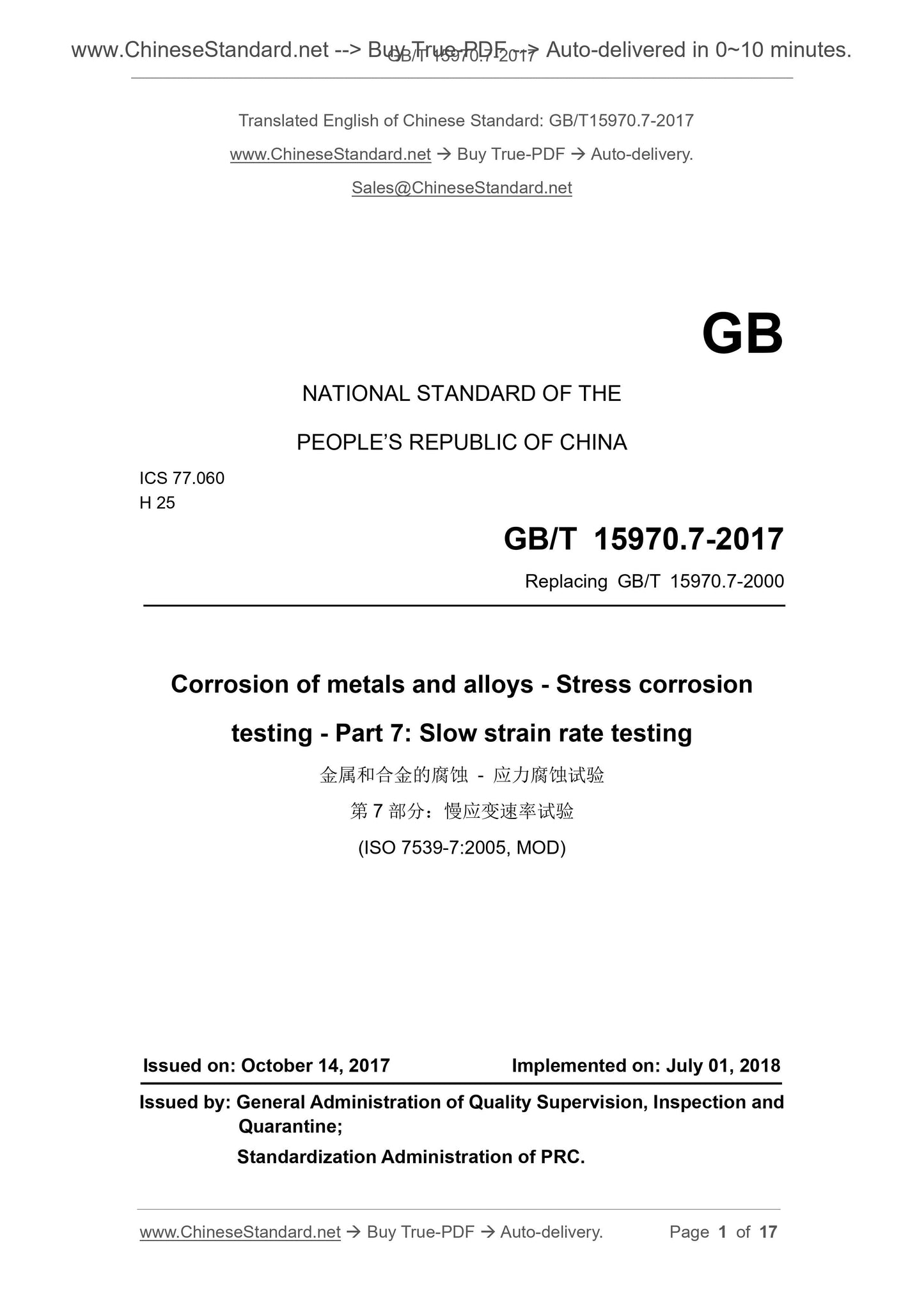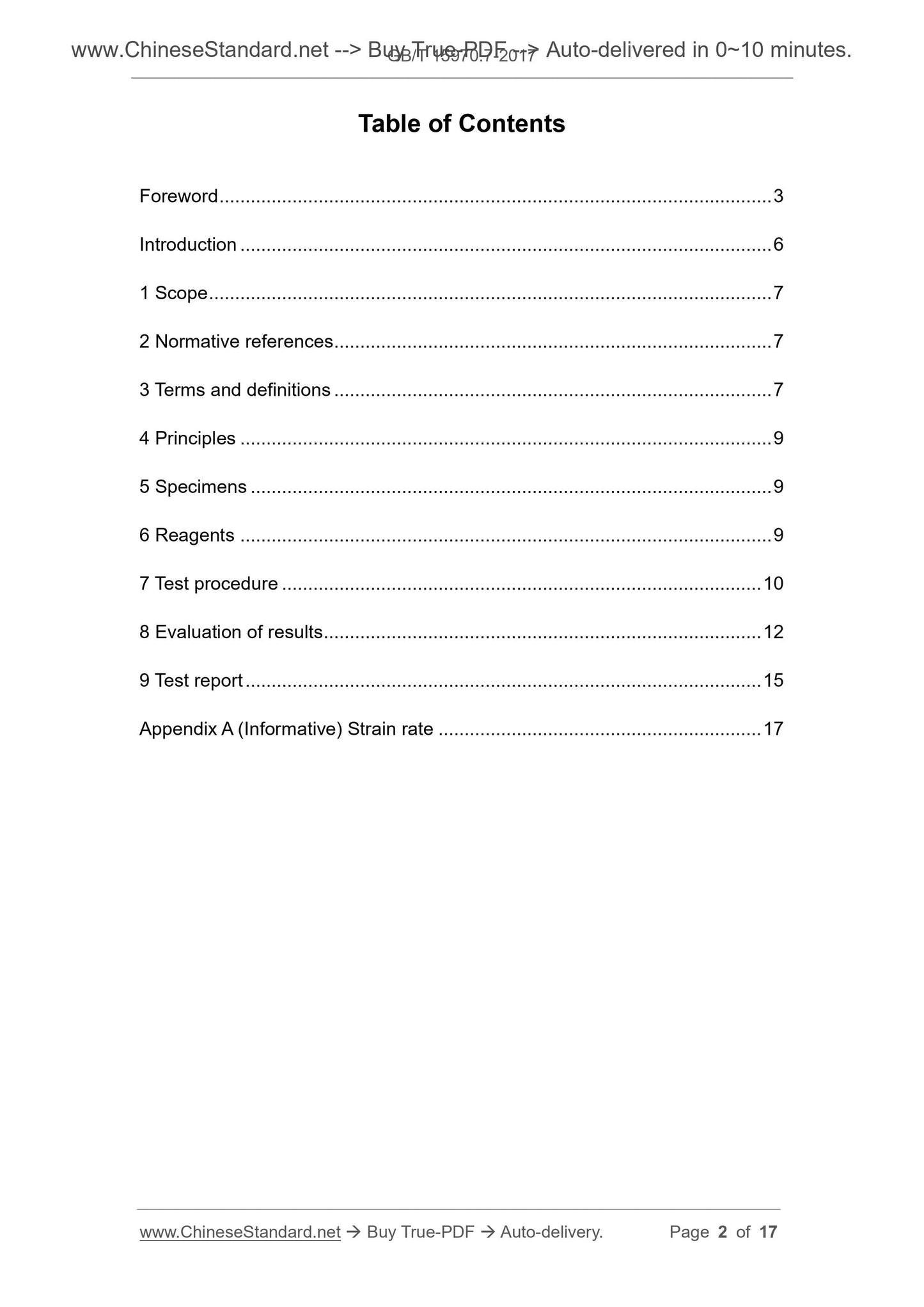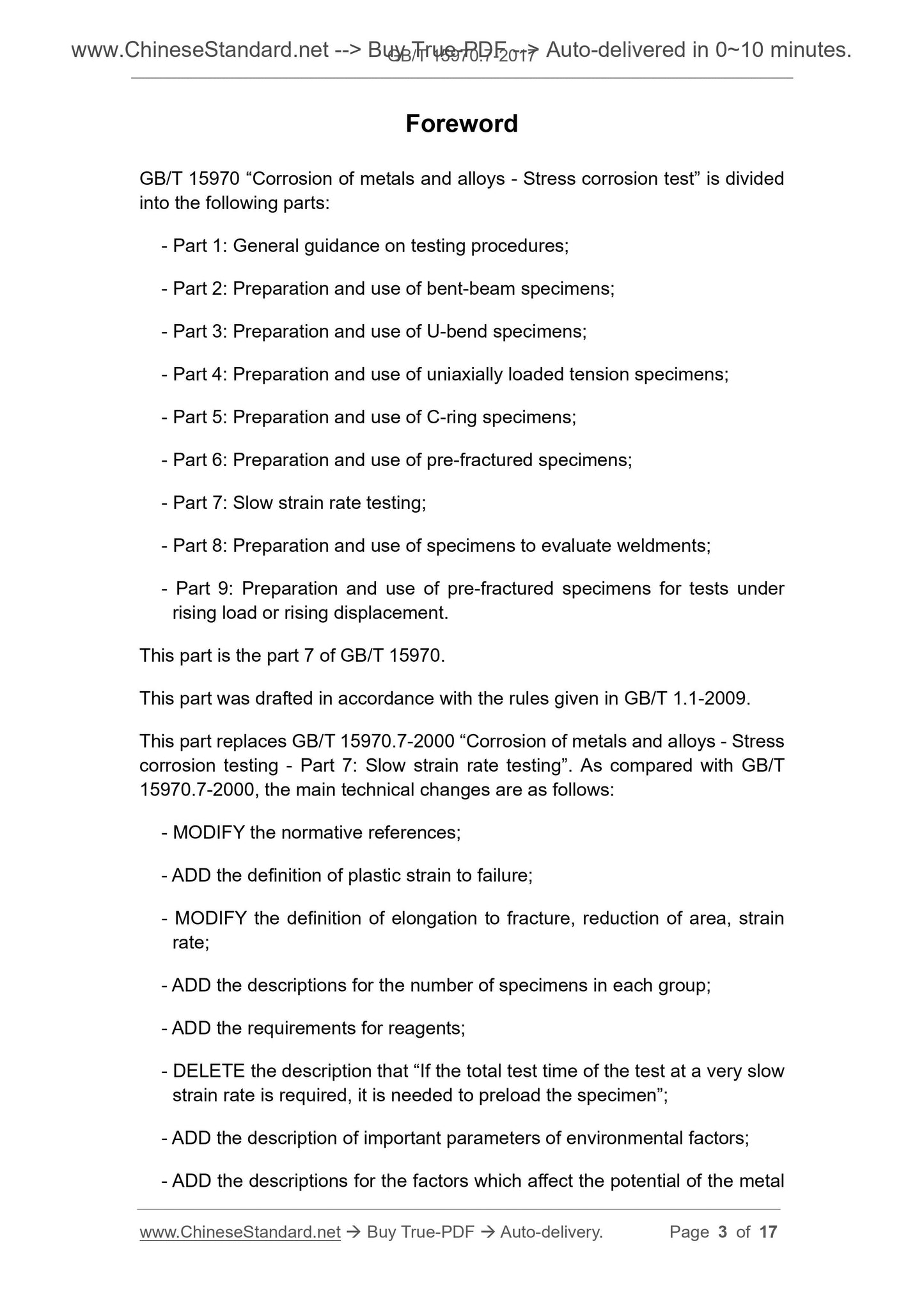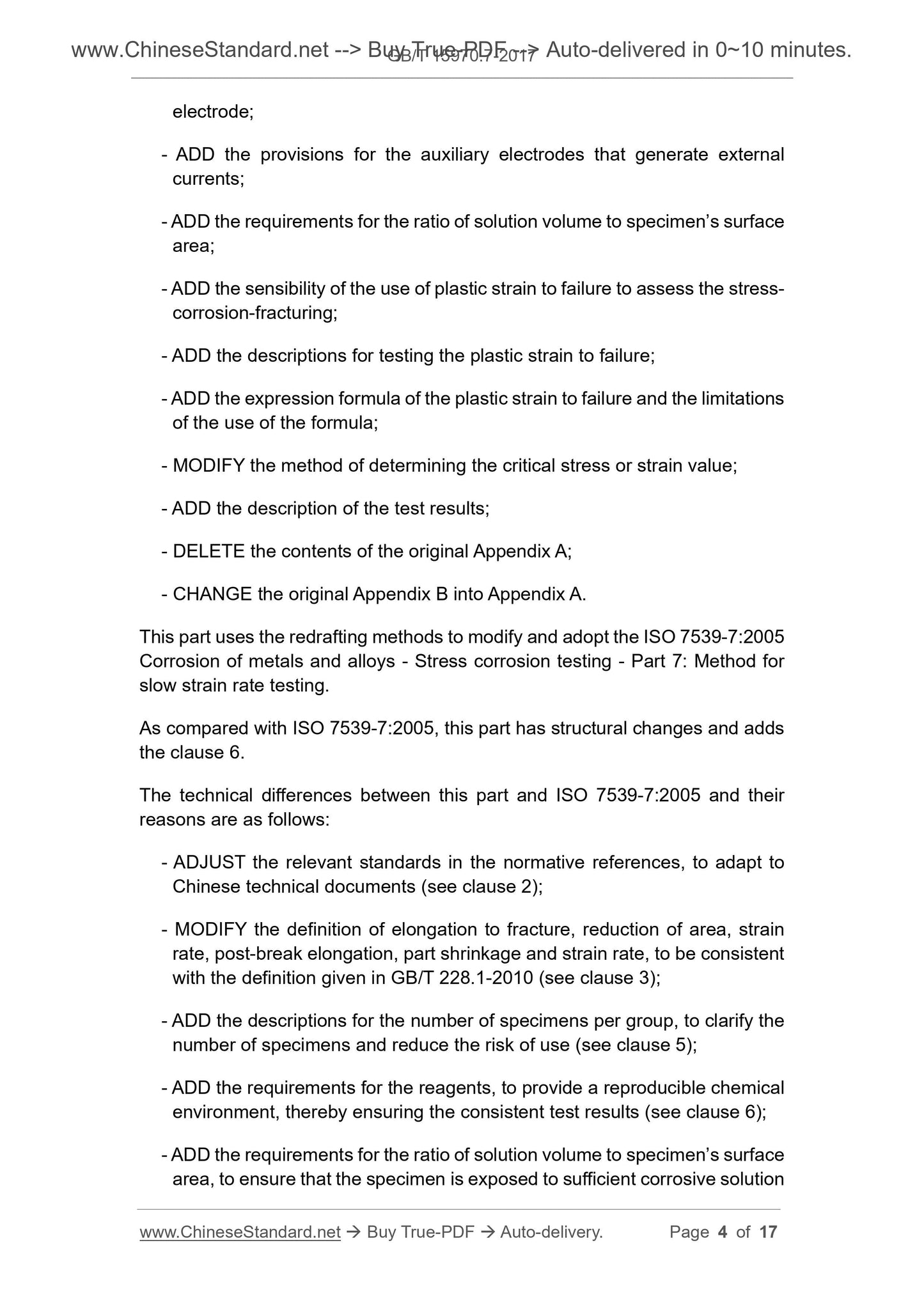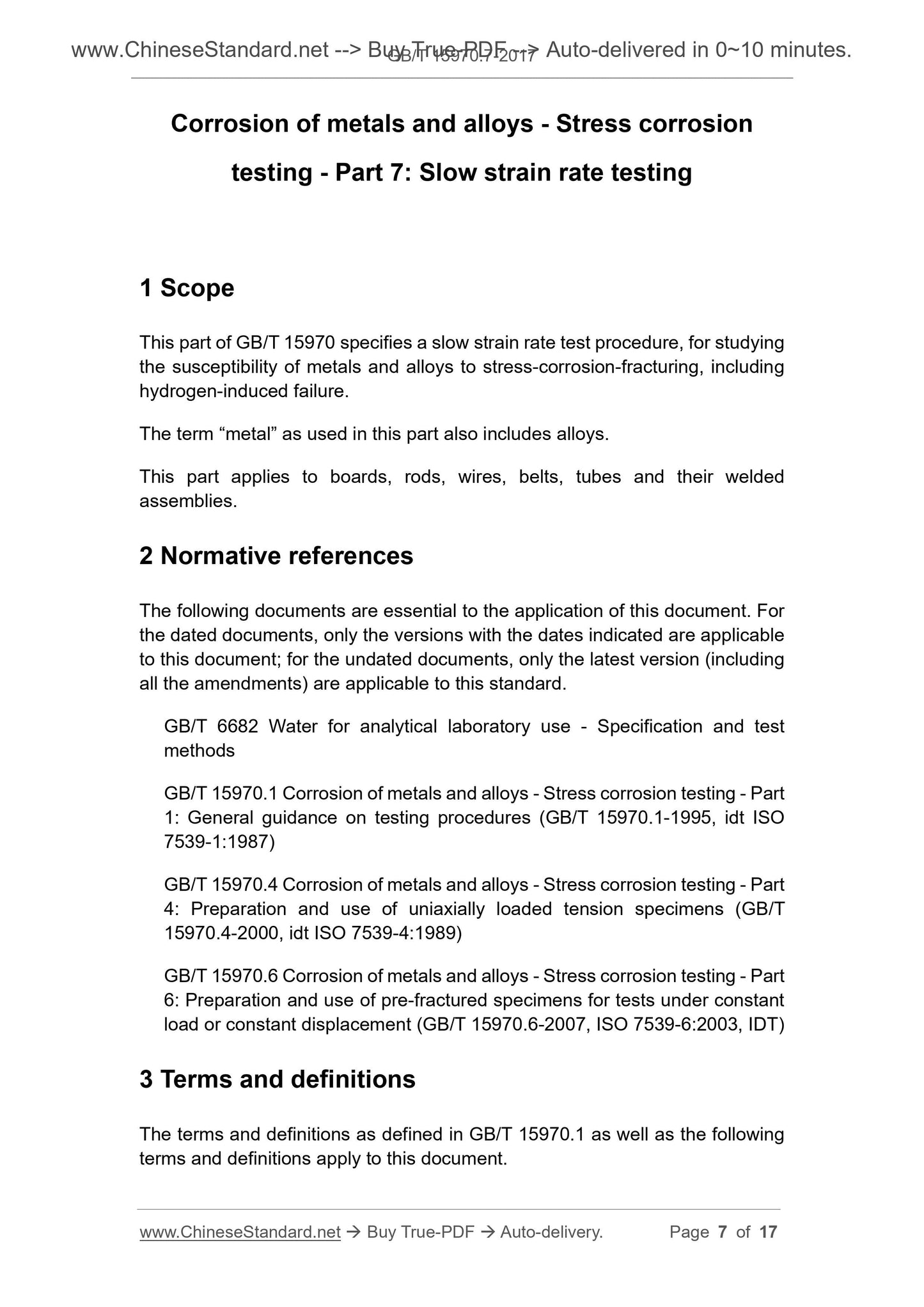1
/
of
5
www.ChineseStandard.us -- Field Test Asia Pte. Ltd.
GB/T 15970.7-2017 English PDF (GB/T15970.7-2017)
GB/T 15970.7-2017 English PDF (GB/T15970.7-2017)
Regular price
$150.00
Regular price
Sale price
$150.00
Unit price
/
per
Shipping calculated at checkout.
Couldn't load pickup availability
GB/T 15970.7-2017: Corrosion of metals and alloys -- Stress corrosion testing -- Part 7: Slow strain rate testing
Delivery: 9 seconds. Download (& Email) true-PDF + Invoice.
Get Quotation: Click GB/T 15970.7-2017 (Self-service in 1-minute)
Historical versions (Master-website): GB/T 15970.7-2017
Preview True-PDF (Reload/Scroll-down if blank)
GB/T 15970.7-2017
GB
NATIONAL STANDARD OF THE
PEOPLE’S REPUBLIC OF CHINA
ICS 77.060
H 25
Replacing GB/T 15970.7-2000
Corrosion of metals and alloys - Stress corrosion
testing - Part 7. Slow strain rate testing
(ISO 7539-7.2005, MOD)
ISSUED ON. OCTOBER 14, 2017
IMPLEMENTED ON. JULY 01, 2018
Issued by. General Administration of Quality Supervision, Inspection and
Quarantine;
Standardization Administration of PRC.
Table of Contents
Foreword ... 3
Introduction ... 6
1 Scope ... 7
2 Normative references ... 7
3 Terms and definitions ... 7
4 Principles ... 9
5 Specimens ... 9
6 Reagents ... 9
7 Test procedure ... 10
8 Evaluation of results ... 12
9 Test report ... 15
Appendix A (Informative) Strain rate ... 17
Foreword
GB/T 15970 “Corrosion of metals and alloys - Stress corrosion test” is divided
into the following parts.
- Part 1. General guidance on testing procedures;
- Part 2. Preparation and use of bent-beam specimens;
- Part 3. Preparation and use of U-bend specimens;
- Part 4. Preparation and use of uniaxially loaded tension specimens;
- Part 5. Preparation and use of C-ring specimens;
- Part 6. Preparation and use of pre-fractured specimens;
- Part 7. Slow strain rate testing;
- Part 8. Preparation and use of specimens to evaluate weldments;
- Part 9. Preparation and use of pre-fractured specimens for tests under
rising load or rising displacement.
This part is the part 7 of GB/T 15970.
This part was drafted in accordance with the rules given in GB/T 1.1-2009.
This part replaces GB/T 15970.7-2000 “Corrosion of metals and alloys - Stress
corrosion testing - Part 7. Slow strain rate testing”. As compared with GB/T
15970.7-2000, the main technical changes are as follows.
- MODIFY the normative references;
- ADD the definition of plastic strain to failure;
- MODIFY the definition of elongation to fracture, reduction of area, strain
rate;
- ADD the descriptions for the number of specimens in each group;
- ADD the requirements for reagents;
- DELETE the description that “If the total test time of the test at a very slow
strain rate is required, it is needed to preload the specimen”;
- ADD the description of important parameters of environmental factors;
- ADD the descriptions for the factors which affect the potential of the metal
electrode;
- ADD the provisions for the auxiliary electrodes that generate external
currents;
- ADD the requirements for the ratio of solution volume to specimen’s surface
area;
- ADD the sensibility of the use of plastic strain to failure to assess the stress-
corrosion-fracturing;
- ADD the descriptions for testing the plastic strain to failure;
- ADD the expression formula of the plastic strain to failure and the limitations
of the use of the formula;
- MODIFY the method of determining the critical stress or strain value;
- ADD the description of the test results;
- DELETE the contents of the original Appendix A;
- CHANGE the original Appendix B into Appendix A.
This part uses the redrafting methods to modify and adopt the ISO 7539-7.2005
Corrosion of metals and alloys - Stress corrosion testing - Part 7. Method for
slow strain rate testing.
As compared with ISO 7539-7.2005, this part has structural changes and adds
the clause 6.
The technical differences between this part and ISO 7539-7.2005 and their
reasons are as follows.
- ADJUST the relevant standards in the normative references, to adapt to
Chinese technical documents (see clause 2);
- MODIFY the definition of elongation to fracture, reduction of area, strain
rate, post-break elongation, part shrinkage and strain rate, to be consistent
with the definition given in GB/T 228.1-2010 (see clause 3);
- ADD the descriptions for the number of specimens per group, to clarify the
number of specimens and reduce the risk of use (see clause 5);
- ADD the requirements for the reagents, to provide a reproducible chemical
environment, thereby ensuring the consistent test results (see clause 6);
- ADD the requirements for the ratio of solution volume to specimen’s surface
area, to ensure that the specimen is exposed to sufficient corrosive solution
Corrosion of metals and alloys - Stress corrosion
testing - Part 7. Slow strain rate testing
1 Scope
This part of GB/T 15970 specifies a slow strain rate test procedure, for studying
the susceptibility of metals and alloys to stress-corrosion-fracturing, including
hydrogen-induced failure.
The term “metal” as used in this part also includes alloys.
This part applies to boards, rods, wires, belts, tubes and their welded
assemblies.
2 Normative references
The following documents are essential to the application of this document. For
the dated documents, only the versions with the dates indicated are applicable
to this document; for the undated documents, only the latest version (including
all the amendments) are applicable to this standard.
GB/T 6682 Water for analytical laboratory use - Specification and test
methods
GB/T 15970.1 Corrosion of metals and alloys - Stress corrosion testing - Part
1. General guidance on testing procedures (GB/T 15970.1-1995, idt ISO
7539-1.1987)
GB/T 15970.4 Corrosion of metals and alloys - Stress corrosion testing - Part
4. Preparation and use of uniaxially loaded tension specimens (GB/T
15970.4-2000, idt ISO 7539-4.1989)
GB/T 15970.6 Corrosion of metals and alloys - Stress corrosion testing - Part
6. Preparation and use of pre-fractured specimens for tests under constant
load or constant displacement (GB/T 15970.6-2007, ISO 7539-6.2003, IDT)
3 Terms and definitions
The terms and definitions as defined in GB/T 15970.1 as well as the following
terms and definitions apply to this document.
GB/T 15970.7-2017
GB
NATIONAL STANDARD OF THE
PEOPLE’S REPUBLIC OF CHINA
ICS 77.060
H 25
Replacing GB/T 15970.7-2000
Corrosion of metals and alloys - Stress corrosion
testing - Part 7. Slow strain rate testing
(ISO 7539-7.2005, MOD)
ISSUED ON. OCTOBER 14, 2017
IMPLEMENTED ON. JULY 01, 2018
Issued by. General Administration of Quality Supervision, Inspection and
Quarantine;
Standardization Administration of PRC.
Table of Contents
Foreword ... 3
Introduction ... 6
1 Scope ... 7
2 Normative references ... 7
3 Terms and definitions ... 7
4 Principles ... 9
5 Specimens ... 9
6 Reagents ... 9
7 Test procedure ... 10
8 Evaluation of results ... 12
9 Test report ... 15
Appendix A (Informative) Strain rate ... 17
Foreword
GB/T 15970 “Corrosion of metals and alloys - Stress corrosion test” is divided
into the following parts.
- Part 1. General guidance on testing procedures;
- Part 2. Preparation and use of bent-beam specimens;
- Part 3. Preparation and use of U-bend specimens;
- Part 4. Preparation and use of uniaxially loaded tension specimens;
- Part 5. Preparation and use of C-ring specimens;
- Part 6. Preparation and use of pre-fractured specimens;
- Part 7. Slow strain rate testing;
- Part 8. Preparation and use of specimens to evaluate weldments;
- Part 9. Preparation and use of pre-fractured specimens for tests under
rising load or rising displacement.
This part is the part 7 of GB/T 15970.
This part was drafted in accordance with the rules given in GB/T 1.1-2009.
This part replaces GB/T 15970.7-2000 “Corrosion of metals and alloys - Stress
corrosion testing - Part 7. Slow strain rate testing”. As compared with GB/T
15970.7-2000, the main technical changes are as follows.
- MODIFY the normative references;
- ADD the definition of plastic strain to failure;
- MODIFY the definition of elongation to fracture, reduction of area, strain
rate;
- ADD the descriptions for the number of specimens in each group;
- ADD the requirements for reagents;
- DELETE the description that “If the total test time of the test at a very slow
strain rate is required, it is needed to preload the specimen”;
- ADD the description of important parameters of environmental factors;
- ADD the descriptions for the factors which affect the potential of the metal
electrode;
- ADD the provisions for the auxiliary electrodes that generate external
currents;
- ADD the requirements for the ratio of solution volume to specimen’s surface
area;
- ADD the sensibility of the use of plastic strain to failure to assess the stress-
corrosion-fracturing;
- ADD the descriptions for testing the plastic strain to failure;
- ADD the expression formula of the plastic strain to failure and the limitations
of the use of the formula;
- MODIFY the method of determining the critical stress or strain value;
- ADD the description of the test results;
- DELETE the contents of the original Appendix A;
- CHANGE the original Appendix B into Appendix A.
This part uses the redrafting methods to modify and adopt the ISO 7539-7.2005
Corrosion of metals and alloys - Stress corrosion testing - Part 7. Method for
slow strain rate testing.
As compared with ISO 7539-7.2005, this part has structural changes and adds
the clause 6.
The technical differences between this part and ISO 7539-7.2005 and their
reasons are as follows.
- ADJUST the relevant standards in the normative references, to adapt to
Chinese technical documents (see clause 2);
- MODIFY the definition of elongation to fracture, reduction of area, strain
rate, post-break elongation, part shrinkage and strain rate, to be consistent
with the definition given in GB/T 228.1-2010 (see clause 3);
- ADD the descriptions for the number of specimens per group, to clarify the
number of specimens and reduce the risk of use (see clause 5);
- ADD the requirements for the reagents, to provide a reproducible chemical
environment, thereby ensuring the consistent test results (see clause 6);
- ADD the requirements for the ratio of solution volume to specimen’s surface
area, to ensure that the specimen is exposed to sufficient corrosive solution
Corrosion of metals and alloys - Stress corrosion
testing - Part 7. Slow strain rate testing
1 Scope
This part of GB/T 15970 specifies a slow strain rate test procedure, for studying
the susceptibility of metals and alloys to stress-corrosion-fracturing, including
hydrogen-induced failure.
The term “metal” as used in this part also includes alloys.
This part applies to boards, rods, wires, belts, tubes and their welded
assemblies.
2 Normative references
The following documents are essential to the application of this document. For
the dated documents, only the versions with the dates indicated are applicable
to this document; for the undated documents, only the latest version (including
all the amendments) are applicable to this standard.
GB/T 6682 Water for analytical laboratory use - Specification and test
methods
GB/T 15970.1 Corrosion of metals and alloys - Stress corrosion testing - Part
1. General guidance on testing procedures (GB/T 15970.1-1995, idt ISO
7539-1.1987)
GB/T 15970.4 Corrosion of metals and alloys - Stress corrosion testing - Part
4. Preparation and use of uniaxially loaded tension specimens (GB/T
15970.4-2000, idt ISO 7539-4.1989)
GB/T 15970.6 Corrosion of metals and alloys - Stress corrosion testing - Part
6. Preparation and use of pre-fractured specimens for tests under constant
load or constant displacement (GB/T 15970.6-2007, ISO 7539-6.2003, IDT)
3 Terms and definitions
The terms and definitions as defined in GB/T 15970.1 as well as the following
terms and definitions apply to this document.
Delivery: 9 seconds. Download (& Email) true-PDF + Invoice.
Get Quotation: Click GB/T 15970.7-2017 (Self-service in 1-minute)
Historical versions (Master-website): GB/T 15970.7-2017
Preview True-PDF (Reload/Scroll-down if blank)
GB/T 15970.7-2017
GB
NATIONAL STANDARD OF THE
PEOPLE’S REPUBLIC OF CHINA
ICS 77.060
H 25
Replacing GB/T 15970.7-2000
Corrosion of metals and alloys - Stress corrosion
testing - Part 7. Slow strain rate testing
(ISO 7539-7.2005, MOD)
ISSUED ON. OCTOBER 14, 2017
IMPLEMENTED ON. JULY 01, 2018
Issued by. General Administration of Quality Supervision, Inspection and
Quarantine;
Standardization Administration of PRC.
Table of Contents
Foreword ... 3
Introduction ... 6
1 Scope ... 7
2 Normative references ... 7
3 Terms and definitions ... 7
4 Principles ... 9
5 Specimens ... 9
6 Reagents ... 9
7 Test procedure ... 10
8 Evaluation of results ... 12
9 Test report ... 15
Appendix A (Informative) Strain rate ... 17
Foreword
GB/T 15970 “Corrosion of metals and alloys - Stress corrosion test” is divided
into the following parts.
- Part 1. General guidance on testing procedures;
- Part 2. Preparation and use of bent-beam specimens;
- Part 3. Preparation and use of U-bend specimens;
- Part 4. Preparation and use of uniaxially loaded tension specimens;
- Part 5. Preparation and use of C-ring specimens;
- Part 6. Preparation and use of pre-fractured specimens;
- Part 7. Slow strain rate testing;
- Part 8. Preparation and use of specimens to evaluate weldments;
- Part 9. Preparation and use of pre-fractured specimens for tests under
rising load or rising displacement.
This part is the part 7 of GB/T 15970.
This part was drafted in accordance with the rules given in GB/T 1.1-2009.
This part replaces GB/T 15970.7-2000 “Corrosion of metals and alloys - Stress
corrosion testing - Part 7. Slow strain rate testing”. As compared with GB/T
15970.7-2000, the main technical changes are as follows.
- MODIFY the normative references;
- ADD the definition of plastic strain to failure;
- MODIFY the definition of elongation to fracture, reduction of area, strain
rate;
- ADD the descriptions for the number of specimens in each group;
- ADD the requirements for reagents;
- DELETE the description that “If the total test time of the test at a very slow
strain rate is required, it is needed to preload the specimen”;
- ADD the description of important parameters of environmental factors;
- ADD the descriptions for the factors which affect the potential of the metal
electrode;
- ADD the provisions for the auxiliary electrodes that generate external
currents;
- ADD the requirements for the ratio of solution volume to specimen’s surface
area;
- ADD the sensibility of the use of plastic strain to failure to assess the stress-
corrosion-fracturing;
- ADD the descriptions for testing the plastic strain to failure;
- ADD the expression formula of the plastic strain to failure and the limitations
of the use of the formula;
- MODIFY the method of determining the critical stress or strain value;
- ADD the description of the test results;
- DELETE the contents of the original Appendix A;
- CHANGE the original Appendix B into Appendix A.
This part uses the redrafting methods to modify and adopt the ISO 7539-7.2005
Corrosion of metals and alloys - Stress corrosion testing - Part 7. Method for
slow strain rate testing.
As compared with ISO 7539-7.2005, this part has structural changes and adds
the clause 6.
The technical differences between this part and ISO 7539-7.2005 and their
reasons are as follows.
- ADJUST the relevant standards in the normative references, to adapt to
Chinese technical documents (see clause 2);
- MODIFY the definition of elongation to fracture, reduction of area, strain
rate, post-break elongation, part shrinkage and strain rate, to be consistent
with the definition given in GB/T 228.1-2010 (see clause 3);
- ADD the descriptions for the number of specimens per group, to clarify the
number of specimens and reduce the risk of use (see clause 5);
- ADD the requirements for the reagents, to provide a reproducible chemical
environment, thereby ensuring the consistent test results (see clause 6);
- ADD the requirements for the ratio of solution volume to specimen’s surface
area, to ensure that the specimen is exposed to sufficient corrosive solution
Corrosion of metals and alloys - Stress corrosion
testing - Part 7. Slow strain rate testing
1 Scope
This part of GB/T 15970 specifies a slow strain rate test procedure, for studying
the susceptibility of metals and alloys to stress-corrosion-fracturing, including
hydrogen-induced failure.
The term “metal” as used in this part also includes alloys.
This part applies to boards, rods, wires, belts, tubes and their welded
assemblies.
2 Normative references
The following documents are essential to the application of this document. For
the dated documents, only the versions with the dates indicated are applicable
to this document; for the undated documents, only the latest version (including
all the amendments) are applicable to this standard.
GB/T 6682 Water for analytical laboratory use - Specification and test
methods
GB/T 15970.1 Corrosion of metals and alloys - Stress corrosion testing - Part
1. General guidance on testing procedures (GB/T 15970.1-1995, idt ISO
7539-1.1987)
GB/T 15970.4 Corrosion of metals and alloys - Stress corrosion testing - Part
4. Preparation and use of uniaxially loaded tension specimens (GB/T
15970.4-2000, idt ISO 7539-4.1989)
GB/T 15970.6 Corrosion of metals and alloys - Stress corrosion testing - Part
6. Preparation and use of pre-fractured specimens for tests under constant
load or constant displacement (GB/T 15970.6-2007, ISO 7539-6.2003, IDT)
3 Terms and definitions
The terms and definitions as defined in GB/T 15970.1 as well as the following
terms and definitions apply to this document.
GB/T 15970.7-2017
GB
NATIONAL STANDARD OF THE
PEOPLE’S REPUBLIC OF CHINA
ICS 77.060
H 25
Replacing GB/T 15970.7-2000
Corrosion of metals and alloys - Stress corrosion
testing - Part 7. Slow strain rate testing
(ISO 7539-7.2005, MOD)
ISSUED ON. OCTOBER 14, 2017
IMPLEMENTED ON. JULY 01, 2018
Issued by. General Administration of Quality Supervision, Inspection and
Quarantine;
Standardization Administration of PRC.
Table of Contents
Foreword ... 3
Introduction ... 6
1 Scope ... 7
2 Normative references ... 7
3 Terms and definitions ... 7
4 Principles ... 9
5 Specimens ... 9
6 Reagents ... 9
7 Test procedure ... 10
8 Evaluation of results ... 12
9 Test report ... 15
Appendix A (Informative) Strain rate ... 17
Foreword
GB/T 15970 “Corrosion of metals and alloys - Stress corrosion test” is divided
into the following parts.
- Part 1. General guidance on testing procedures;
- Part 2. Preparation and use of bent-beam specimens;
- Part 3. Preparation and use of U-bend specimens;
- Part 4. Preparation and use of uniaxially loaded tension specimens;
- Part 5. Preparation and use of C-ring specimens;
- Part 6. Preparation and use of pre-fractured specimens;
- Part 7. Slow strain rate testing;
- Part 8. Preparation and use of specimens to evaluate weldments;
- Part 9. Preparation and use of pre-fractured specimens for tests under
rising load or rising displacement.
This part is the part 7 of GB/T 15970.
This part was drafted in accordance with the rules given in GB/T 1.1-2009.
This part replaces GB/T 15970.7-2000 “Corrosion of metals and alloys - Stress
corrosion testing - Part 7. Slow strain rate testing”. As compared with GB/T
15970.7-2000, the main technical changes are as follows.
- MODIFY the normative references;
- ADD the definition of plastic strain to failure;
- MODIFY the definition of elongation to fracture, reduction of area, strain
rate;
- ADD the descriptions for the number of specimens in each group;
- ADD the requirements for reagents;
- DELETE the description that “If the total test time of the test at a very slow
strain rate is required, it is needed to preload the specimen”;
- ADD the description of important parameters of environmental factors;
- ADD the descriptions for the factors which affect the potential of the metal
electrode;
- ADD the provisions for the auxiliary electrodes that generate external
currents;
- ADD the requirements for the ratio of solution volume to specimen’s surface
area;
- ADD the sensibility of the use of plastic strain to failure to assess the stress-
corrosion-fracturing;
- ADD the descriptions for testing the plastic strain to failure;
- ADD the expression formula of the plastic strain to failure and the limitations
of the use of the formula;
- MODIFY the method of determining the critical stress or strain value;
- ADD the description of the test results;
- DELETE the contents of the original Appendix A;
- CHANGE the original Appendix B into Appendix A.
This part uses the redrafting methods to modify and adopt the ISO 7539-7.2005
Corrosion of metals and alloys - Stress corrosion testing - Part 7. Method for
slow strain rate testing.
As compared with ISO 7539-7.2005, this part has structural changes and adds
the clause 6.
The technical differences between this part and ISO 7539-7.2005 and their
reasons are as follows.
- ADJUST the relevant standards in the normative references, to adapt to
Chinese technical documents (see clause 2);
- MODIFY the definition of elongation to fracture, reduction of area, strain
rate, post-break elongation, part shrinkage and strain rate, to be consistent
with the definition given in GB/T 228.1-2010 (see clause 3);
- ADD the descriptions for the number of specimens per group, to clarify the
number of specimens and reduce the risk of use (see clause 5);
- ADD the requirements for the reagents, to provide a reproducible chemical
environment, thereby ensuring the consistent test results (see clause 6);
- ADD the requirements for the ratio of solution volume to specimen’s surface
area, to ensure that the specimen is exposed to sufficient corrosive solution
Corrosion of metals and alloys - Stress corrosion
testing - Part 7. Slow strain rate testing
1 Scope
This part of GB/T 15970 specifies a slow strain rate test procedure, for studying
the susceptibility of metals and alloys to stress-corrosion-fracturing, including
hydrogen-induced failure.
The term “metal” as used in this part also includes alloys.
This part applies to boards, rods, wires, belts, tubes and their welded
assemblies.
2 Normative references
The following documents are essential to the application of this document. For
the dated documents, only the versions with the dates indicated are applicable
to this document; for the undated documents, only the latest version (including
all the amendments) are applicable to this standard.
GB/T 6682 Water for analytical laboratory use - Specification and test
methods
GB/T 15970.1 Corrosion of metals and alloys - Stress corrosion testing - Part
1. General guidance on testing procedures (GB/T 15970.1-1995, idt ISO
7539-1.1987)
GB/T 15970.4 Corrosion of metals and alloys - Stress corrosion testing - Part
4. Preparation and use of uniaxially loaded tension specimens (GB/T
15970.4-2000, idt ISO 7539-4.1989)
GB/T 15970.6 Corrosion of metals and alloys - Stress corrosion testing - Part
6. Preparation and use of pre-fractured specimens for tests under constant
load or constant displacement (GB/T 15970.6-2007, ISO 7539-6.2003, IDT)
3 Terms and definitions
The terms and definitions as defined in GB/T 15970.1 as well as the following
terms and definitions apply to this document.
Share
